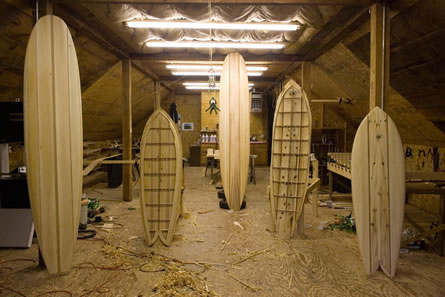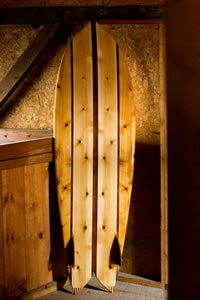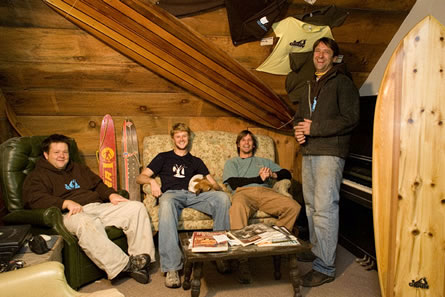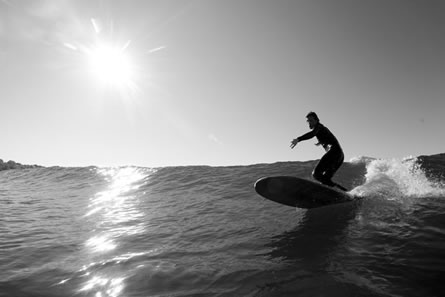Grain Surfboards
The state of Maine is known more for its boat building and sailing than for its wintry point breaks. From this rich boat building tradition emerges Grain Surfboards -a group of craftsmen led by helmsman Mike LaVecchia making hollow wood boards.

In a short time Grain has developed a loyal customer base in both their DIY kits and complete boards. They have received a lot of media attention from traditional media sources, surfing publications and even environmental media outlets like Current TV Earth. Their hip website features a builder’s blog and crisp photographs of their boards both in and out of the water. In one of our earlier posts we featured a short documentary about Grain hosted by Current TV. You can watch the video again here.
We really like Grain because they make a public commitment to being environmentally conscious. The wood used for their boards is harvested from local and sustainably managed forests. They also mill the wood in house and ensure that there is little waste by using scraps for tail blocks and fins. They try to maximize their resources while maintaining a high quality product.
We contacted Mike LaVecchia a while back to see if he would be interested in talking with us about his work, his inspiration, surfing life in Maine and his ideas about sustainability. Enjoy.
How did you get into building wooden surfboards, what shapers/designers influenced your work?
I grew up juggling my time between skateboarding, snowboarding and sailing, but really loved all three. I find that when I get into something, I have to go all the way with it. I spent years working for Burton Snowboards, and then enjoyed years of working on – and under – wooden boats. Over time, most of my good friends gravitated towards surfing. While I knew I would enjoy it, I had a hard time pulling away from the other things I loved, and suspected that once I tried it, everything would change. One fall a few years ago, we all rented a house on Cape Cod, and before I knew it, I had bought an old Yater Spoon and a wetsuit. That afternoon, I tried surfing some shin high wind swell and was hooked.
Within a year, I quit my job, sold my boat, and had moved to the coast of Maine. I was soon working for a local boat builder but dreaming about building surfboards. I started sketching out a construction method that would allow us to experiment with wood, but keep the board as light as possible. At the time, I was inspired most by Tom Wegener, Paul Jensen and Greg Noll. For me, surfing really combines my need to be on the water with my lifelong love of board sports.
What kinds of responses do you get from the surfing public about the boards you make? Have you had any experiences with people who are turned off by wooden boards?
The surfing community really seems to be embracing what we’re doing. I think the recent demise of Clark Foam and the realization of how damaging foam production can be for our environment has given people a renewed interest in making surfing more sustainable. I think a lot of eyes have been opened.
We’re realistic in terms of the marketability of our boards. We know that wooden surfboards will appeal to some, and not all. While they are as hollow as a hollow board can be, they are still slightly heavier then a lightly glassed foam board. But for the surfer looking for a true longboard feel or a retro shortboard experience, you can’t beat a real wooden board. We’re also working hard to keep our prices as low as possible. We don’t want our boards to be wall hangers, we feel much better knowing that they are being used on a daily basis, and hope our prices and product line reflect that.
What does sustainability mean to you and your construction philosophy?
To me, sustainability means that people are concerned about the future of the environment around them and are responsibly managing natural resources for future generations even as those resources are used to meet present needs. In a global sense, sustainability is often more of an ideal we continually move toward rather than an absolute practice. For instance, the Northern White Cedar we use in our boards which is regarded by foresters as “sustainably harvested” is handled using heavy equipment (like “skidders”, mills and logging trucks) that are manufactured using unsustainable methods and run on petroleum products which are not renewable.
 At Grain Surfboards, we apply a sustainability ethic to our choice of materials, vendors and construction method. For instance, we are continually learning more about sustainable forestry – protecting the stands of Northern White Cedar by ensuring adequate seeding and the ability of the forest soils to support regeneration – but we also make an effort to buy locally in order to support our neighbors and cut down on fuel consumption by lessening transport requirements.
At Grain Surfboards, we apply a sustainability ethic to our choice of materials, vendors and construction method. For instance, we are continually learning more about sustainable forestry – protecting the stands of Northern White Cedar by ensuring adequate seeding and the ability of the forest soils to support regeneration – but we also make an effort to buy locally in order to support our neighbors and cut down on fuel consumption by lessening transport requirements.
Purely in terms of construction, we spent a lot of time developing methods that make maximal use of the material. We have invested in equipment that allows us to more efficiently re-saw our planks instead of planning them, meaning that we can get three quarter-inch planks from a one-inch board. In the end, we make use of just about every cut-off; plank ends become tail blocks and edgings become “rail strips”. Our boards are built hollow from the keel to the rails, but the wood we put into our boards stays in our boards. By this I mean that we reduce the amount of wood required to construct these boards through careful milling, instead of turning the insides to waste through the chambering process. The waste we do produce has been reduced to a very small amount, most of which is composted or is used at local horse farms for stall bedding.
One of the things that we want to explore is the Do-It-Yourself aspect of surfing culture. Tell us a little about your surfboard build-kits and the response you get from enthusiasts?
Since we first started building boards, we’ve struggled with the concept of designing and building a board from the inside out for performance, aesthetic beauty and low weight. As we worked through the process and refined the final Grain Surfboards method, we finally landed on the production method we currently use. We enjoyed the building process so much that it just seemed like a natural step to offer what we learned to others through our kits. Building a board with your own two hands is an intensely satisfying experience. Surfing your own hand-built surfboard is completely indescribable; there is a truer connection to the wave. Not to mention that building your own board step by step gives you a more complete understanding of why things work as they do between surfboard and wave.
Our Home Grown surfboard kits offer people the opportunity to build a board from scratch, without the knowledge required to design the board or the skills and tools required to mill and prepare the material. We think of each kit as a custom board project. Each kit comes with hand selected planks and rail strips, a machine cut keel and frames specific to the board you are building, all the wood glue, epoxy and fiberglass you need, fin box, leash plug, vent screw, squeegees, latex gloves and more. The kit also includes a 40 page instruction manual to show you the way step by step.
Our kits are getting a great response from the industry. Shops are beginning to carry them, and the shop owners are building them, with more calling every day. Our goal is to offer the wooden surfboard experience to as many people as possible through Home Grown kits – if they are inclined to build their own – and through custom Grain Surfboards which our builders create here in Maine.
Maine does not appear to have a rooted surfing culture like California or Australia. Do you think that the lack of surfing roots in Maine has made it easier for people to embrace wooden boards?
While Maine does not have the culture that California does, people have been surfing here for a long time and the hidden spots that dot our coastline were just as good then as they are now. In terms of our boards, I guess to a lot of people New England, and more importantly Maine, has a great reputation for quality craftsmanship. While a foam board shaper from Maine might not stand out, a couple guys building custom wooden surfboards one at a time just grabs people’s attention.
I suppose we also shouldn’t forget that surfing began with the basic craft of building wooden surfboards. So the roots of surfing match pretty well with what we’re doing out here on the coast of Maine. We think it’s interesting that most of our website traffic, phone calls and inquiries about Grain come from the coastal areas of the west coast and southeast United States. We also are seeing incredible interest from surfers overseas and as far away as Japan. Wooden surfboards are the root of surfing worldwide, and we hope surfers will appreciate returning to these roots for a better experience.

Where do you see the craftsman/shaper tradition in the future of surfing?
It seems to me that one thing that is different about surfing is that it is driven by the shaper. Compare it to any other sport – snowboarding for example; I would venture to guess that there are few individuals making snowboards one at a time in their garages. Most boards are built by a few factories scattered around the world. R&D takes place in a lab with machines pushing the limits of what a board can handle. Are there individuals making custom basketballs for a living, or pushing the limits of golf club designs in their garages? Maybe a few…
But with surfing, it is really all about the experience of shaping and riding a board. The evolution of the sport has been pushed by the surfer/shaper. There maybe a lot of large companies producing surfboards, but I would guess there are five times as many individual shapers enjoying life by shaping surfboards one at a time. And while it is discouraging to see a lot of companies producing cheap boards overseas, it seems to me that the core of the sport and future lies in the hands of the craftspeople.
What’s in store for Grain Surfboards?
Our goal is to make Grain Surfboards a point source for anyone interested in bettering their surfing experience by building and/or riding wooden surfboards. We are working on releasing new shapes, new products and lighter boards. We’d like to have a product priced to meet anyone’s budget. We’d like to have an online store complete with everything you need to build your own wooden surfboard. And we are working on methods that will make our operations greener and more efficient so that we can all feel more like our surfing is part of a sustainable solution rather than a global problem. Our driving mission is to let more people discover that wooden surfboards simply offer a better experience than standard foam. We’re convinced, and hundreds of happy surfers and builders have already come with us.

*All photos courtesy of Nick LaVecchia.
Love it! Have drooled over their website and boards before. Cool interview. Hope they do well.
Amazing craftmenship.
Congradulations on all of your success Grain…
You said something about new shapes…
What do you have in mind…
I’m excited to read more about all of the wonderful things that your company is doing to broaden awareness of sustainability and the enviroment through surfing.
Uhhhh hate to burst your bubble but I hear those guys get thier wood from a clearcutting operation in Northern Maine and Canada. That is not cool.
Uhhhhh…..hate to burst your bubble Justin, but I’ve met the guys that supply all of Grain’s wood and it’s not a “clear-cutting operation in Northern Maine”. They are a great company doing a great thing.
Pretty sure, my next board will be a wood. My friend is in the process of making his Grain board by way of the kit, he’s taking his sweet time though. Can’t wait to try it out.
As you can see from the comments above, there have been some claims that Grain is not living up to their sustainability ideals.
This brings up two important points. First off, Phoresia is a web-based resource. Our information is based on first person interviews along with web research. Because we are a small operation we are unable to visit shapers or get product samples for our research. Our goal is simply to collect the information in one place to facilitate further research by you, the consumer. If you are in doubt about a product or service then please do your own research. After all, it is your responsibility as a consumer to ensure that you know what you are buying.
The second point is straightforward. If you feel that what we’ve stated here is incorrect and decide to post a comment, then please include your sources and email address so that readers can follow up on your claim. Otherwise it’s just slander, and slander is not conducive to progress.
Cheers,
Ricardo – Editor
Beautiful boards. Inspiring work. Great interview. And thanks for keeping the discussion on the high ground Ricardo.
Lars
42 Surfboards
I have just completed my first hollow board made from a red pine(californian redwood) door and oregon(douglas fir) ceiling joists that I have ripped up into planks. It looks great and I’m now making a body board with the left overs. I sourced the wood from a recycling junk yard.
A truly 100% recycled board.
Hey Baz,
If you want to do a little write up with photos of your recycled board project we’d love to put it up on Phoresia. Let us know.
Cheers,
rs
Where can I find a SUP (stand up surboard) drawing or DIY kit????
Enrique, you’re best bet is to check out the Grain Surfboards forum for a DIY or instructions on how to design/build your own:
http://www.grainsurf.com/forum/
where can I find neftali espino – surfboard shaper – does he have a shop ?????
man, really need to surf a hollow surfboard… it lights my spirit as a soul longboarder…
gonna try a siebert (check it out at http://www.siebertsurfboards.com/) from Brazil…
But still a lil’ “don’t know for sure” about these…
they are so beautiful tho’ *__*